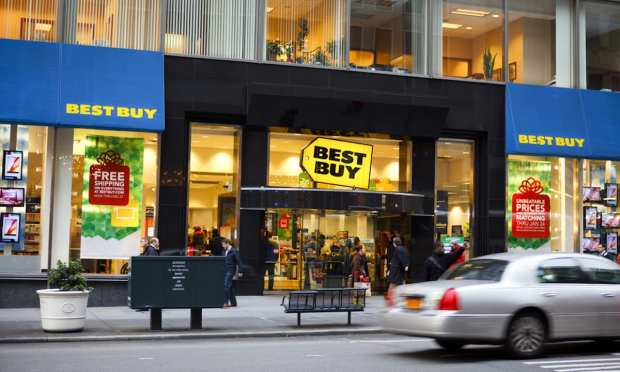Best Buy Earnings Show Positive Impact Of Stay-at-Home Economy

Amid the pandemic, we want our electronics – the TVs, tablets and devices keeping us tethered, at least digitally, to family and friends and binge-watching … and we want more of them.
Best Buy’s first-quarter earnings results released on Thursday (May 27) show that consumers kept spending even into what seem to be the waning months of lockdowns and social distancing. Stimulus payments helped the surge.
Best Buy said that sales grew 36 percent in the fiscal first quarter, as shoppers’ stimulus-fueled spending spree included consumer electronics. Consolidated sales were $11.6 billion, far outpacing the $10.4 billion the Street had expected. Earnings of $2.23 were up more than 220 percent during the same period, and analysts expected $1.42.
Drilling down into the numbers a bit, domestic sales, at $10.8 billion, were up 37 percent year over year. Domestic online revenues were up 7.6 percent on the year, coming in at $3.6 billion. Online sales were 33.2 percent of domestic revenues, down from a 42 percent contribution last year, when lockdowns were firmly entrenched. International revenues were 23 percent higher in the most recent period, reaching $796 million, and comp growth was up 27.9 percent.
In terms of domestic demand, by product category, consumer electronics, at 30 percent of the mix, were up about 46 percent year on year. Appliances, though only 15 percent of the mix, soared by more than 66 percent. Computing and mobile phones, at more than 44 percent of product sales, grew by more than 27 percent.
Pointing to general trends, CEO Corie Barry said in remarks accompanying the earnings report that consumers have shown an increased “focus on the home, which encompasses many aspects of our lives including working, learning, cooking, entertaining, redecorating and remodeling. The demand was also bolstered by government stimulus programs and the strong housing environment.”
Filling Up The New Digs
It stands to reason that people need stuff to fill up all of those houses they bought amid the pandemic. The home-as-hub pivot is firmly in place, which means that we’ll grow ever more connected through devices (hello, Internet of Things!), which could augur well for Best Buy’s results moving forward. That’s especially true as foot traffic starts to return to stores in full force.
Might the consumer continue to spend, feeling that the worst is over and that the wallets can open even more fully? Consider the fact that initial unemployment claims slipped for the fourth straight week, and we’re at multi-month lows since the pandemic wreaked havoc with the economy. Initial jobless claims for the week that ended May 22 came in at 406,000, the Labor Department reported, better than the 425,000 that had been expected.
It’s important to note that the rising commerce tide has been lifting all boats. Best Buy, of course, competes with Amazon, Walmart and a host of others on the consumer electronics front, and yet the strong results this week show that Best Buy is apparently doing just fine. That sanguine outlook is reflected in the fact that the company boosted its full-year comp-store sales forecast to a positive 3 to 6 percent, where previously the company had projected a slide of as much as 2 percent to a gain of 1 percent.
